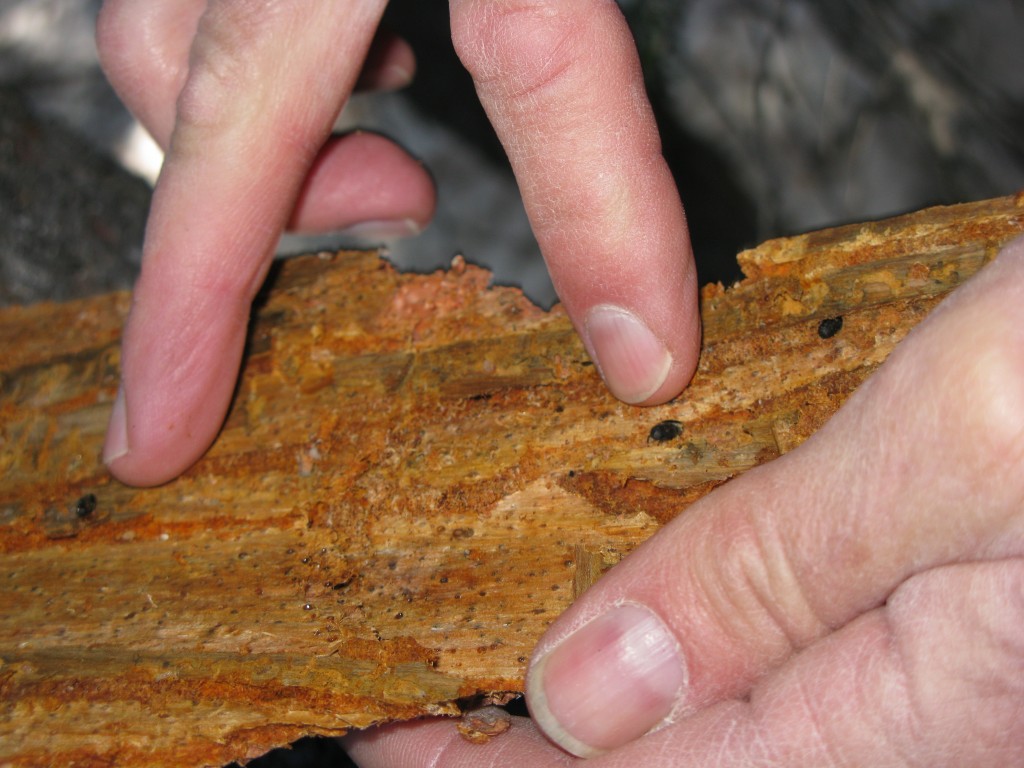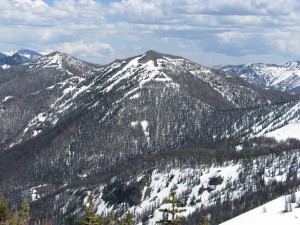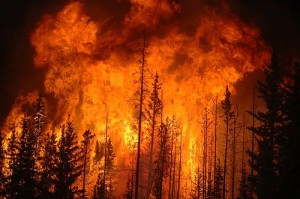
On a cold, clear June morning high in Wyoming’s Wind River Mountains, Jesse Logan stopped on a snow-covered hillside and pointed with his ski pole to a large pine tree. A few of its needles were turning red, a sign of trouble. About a dozen people gathered around him on the snow to listen.
“We got a live one?” a man asked hopefully, pointing out the green needles at the top of a tree with a foot-wide trunk.
“It’s dead and gone, John,” Logan, a trim man with narrow, dark brown eyes, a neat gray goatee, and the self-contained manner of a traditional rural westerner, replied. “It ain’t gonna be green long.”
Until he retired in 2006, Logan ran the beetle research unit for the U.S. Forest Service’s Rocky Mountain Laboratory in Utah. For thirty years, Logan had investigated the relationship between trees and pest insects that plague them, combining sophisticated mathematical modeling of insect – plant warfare and boots-on-the-snow field observations.

On this morning, he was teaching a group of amateur wilderness enthusiasts and conservationists how to size up the health of a long-lived conifer called the whitebark pine, as part of an effort to scientifically assess the health of the tree’s namesake ecosystem. Whitebark pines, which can grow up to sixty feet tall and have whitish trunks, anchor the high-altitude forest of the Rocky Mountains and the Cascades, growing in cold, windswept locations too harsh for other evergreens. Whitebark pine provides essential support to this ecosystem, which is located just below the timberline, creating soil where there was rock, shade where there was sun, and cover for wildlife where there was none. The deep green carpet of whitebark pine that covers the West’s high country is so important it’s been called the “rooftop of the Rockies.”
Today, however, the whitebark pine is in trouble, and the rooftop of the Rockies is crumbling.
Global warming has hit the mountains of the U.S. West harder than anywhere else in the continental United States, raising average temperatures in the eleven-state region a full 1.1°C (2°F) above the twentieth century average. These changes have contributed to infestations of mountain pine beetles that can invade a whitebark pine tree by the thousands, chew up the tissue beneath their bark, and kill the tree. In the high country, severe cold snaps every few winters used to bring temperatures down to -40 C, cold enough to kill off these insects, which are part of a class of pest known as bark beetles, and protect stands of whitebark pine. But it hasn’t gotten that cold in recent years, and today mountain pine beetles are infesting and killing entire stands of centuries-old whitebarks throughout the Cascades and northern Rockies.

At lower elevations in the West, a dryer, warmer climate has rendered other species of pines, including lodgepoles and pinyon pines, defenseless against invading beetles by drying their sap, which would normally drown the invading beetles and poison them with defensive chemicals. As the trees die by the hundreds, forests turn into tinder.
Partly as a result, forest fires have grown larger and more frequent from Mexico to Alaska. California, with its large populations and semiarid climate, has been particularly hard hit. A series of blazes in October 2007, for example, swept across Southern California, from Santa Barbara to the Mexican border, burning half a million acres and forcing a quarter million people to evacuate.
None of this bodes well for human health because smoke from wildfires can affect air quality hundreds or even thousands of miles away, bringing respiratory problems like bronchitis, raising the risk of heart attacks, and spreading toxins from burning houses and electrical wires. But wildfires can scar people in other ways.

In October 2003, the Cedar Fire scorched a large swath of San Diego County, California, sending walls of fire taller than the Statue of Liberty to devour evergreens almost as tall. As the flames approached in the middle of the night, Bob and Sandra Younger barely escaped from their home in Wildcat Canyon, inching down a narrow dirt road in their white Acura with just a few possessions, their two Newfoundland dogs, and their cockatiel. They then drove a mile through walls of flame to safety.
Five years after the blaze, the Youngers had rebuilt their home and their lives, but it was a long, costly, and draining process. Now Sandra looks at the chaparral that quickly grew up on the fire-scorched land around their home with a mix of admiration and suspicion. She feels lucky to have survived the Cedar Fire and to have had decent insurance, but the trauma still hangs like a smoky cloud in their past. Among the various health effects of wildfires, she notes, acute and lasting mental health impacts like the ones she and her neighbors suffered cannot be underestimated.
“It draws a line through your life,” she said. “Everything becomes ‘before the fire’ and ‘after the fire.’”
__
This post is adapted from Changing Planet, Changing Health: How the Climate Crisis Threatens Our Health and What We Can Do about It, by Paul R. Epstein and Dan Ferber (University of California Press, 2011)
Images: Aerial photo of whitebark pine forest, Wind River Mountains; mountain pine beetles; dead whitebark pine forest forest, Yellowstone National Park: Dan Ferber. Wind River Mountains overflight: Bruce Gordon, Ecoflight. Forest fire: 500px-Fire-Forest/Wikimedia Commons.
About a dozen years ago, my son and I were on our annual summer visit to my mother’s (bless her soul) beautiful home on the Sechelt Peninsula in BC.
One morning, in a state of half-sleep, I reached over to stir my young son awake and was shocked to feel a large prickly thing on top of the covers. When I snapped my eyes wide open and looked, I beheld a massive beetle – five centimetres long – that’s two inches – with huge antennae.
Always being the curious sort, I grabbed the strange creature and placed it into a jar, for later examination.
I brought the bug into town and showed it to an old acquaintance – the editor of the local newspaper – who published a picture of myself, my son and the bug under the caption “Don’t bug me, Dad”. (Oh, such humour, eh?)
Of course, being a journalist, like myself, he couldn’t answer my questions about what kind of bug it was, so when I returned home to the big city, I called the head of entomology at Simon Fraser University to learn more about this living oddity.
Based on my over-the-telephone description, the bug was identified as the Ponderous Borer, Ergates spiculatus – not the most common of these tree-eating creatures, but certainly the largest.
At the time, the presence of pine beetles was a little known phenomenon on the northwest coast. Today, it’s a rapidly spreading environmental and economic menace.
The most noticeable impact in my own neighbourhood is on the once lush green landscape of Burke Mountain – one of the many mountains that provide the gorgeous wilderness backdrop for Metro Vancouver – which is now striped with the dead, red trees that have been attacked by the pine beetle scourge. The striped red and green colours may look pretty, but …
Recent BC government estimates indicate that the infestation has now affected a massive 17.5 million hectares of the province’s forests. That’s almost 70,000 square MILES, an area larger than all but the 20 biggest US states.
Excuse my inaccuracy.
70,000 sq. m. is larger than any US state, except the 20 largest.
Just wondering where the authors got their information. The story of my experience in the Cedar Fire is accurate, but I don’t recall speaking directly with the authors. Perhaps so; lots of reporters were interested at the time, but I was just surprised to find my name and story here!
Hi Sandra. Kari Lydersen, who did some reporting for Changing Planet, Changing Health, spoke with you back in 2008. That’s how your story got into our book. Thanks for sharing it, and hope you’re doing well.
Dan Ferber
Dan – Very interesting story. It’s sad to hear stories like that of Burke Mountain. The devastation that bark beetles can cause can be hard to fathom for those who haven’t seen it. We describe some of the numbers for British Columbia in the book, but hearing your account brings it home.
When I was reporting for Changing Planet, Changing Health, Jesse Logan and I climbed a mountain in Yellowstone so he could show me an entire mountainside filled covered with dead or dying whitebark pines. Most of them were many centuries old. It’s shocking and sad when you see that kind of destruction first hand, and it drives home the need to find workable solutions. Thanks for your comment.
Dan Ferber